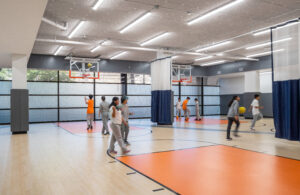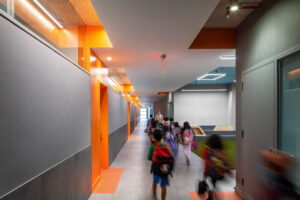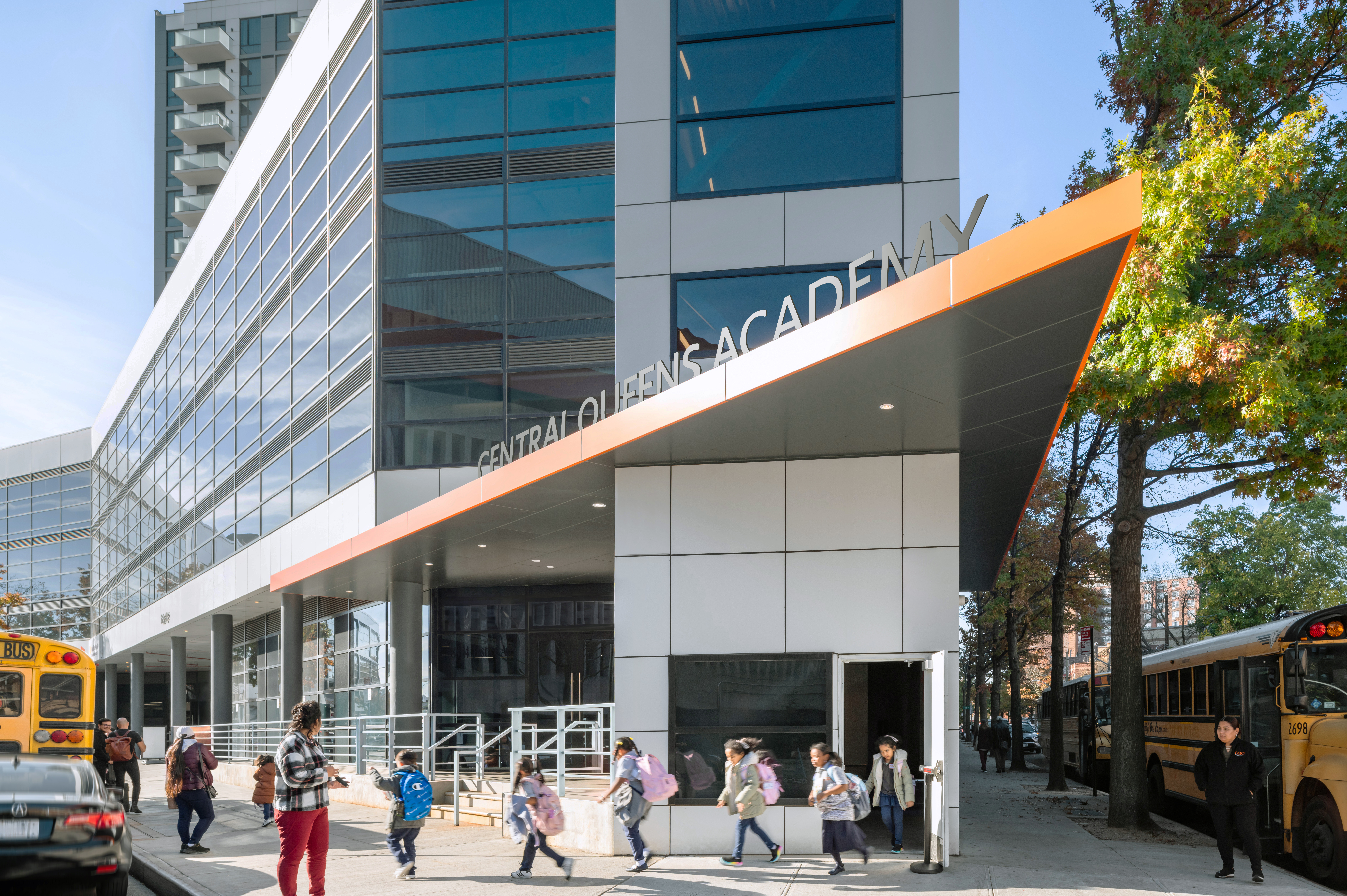Read the full story and see more project images in the July/August issue of School Construction News and subscribe today to receive free editions in your inbox.
Photo: After evaluating nearly 100 different properties, the team selected a portion of an existing mixed-use structure, with the school occupying three expansive podium levels. | Photo Credit (all): Here and Now Agency
By Lindsey Coulter
In the borough of Queens, New York, where land for new construction is scarce, growing schools often struggle to find the right space or structure to support modern teaching and learning. Leaders at Central Queens Academy (CQA) experienced similar challenges when searching for the growing school’s permanent home. Thanks to the partnership and ingenuity of architecture firm GLUCK+, however, for the first time in the school’s more than ten-year history, the entire CQA community is now united under one roof.
The Search for a Site

CQA opened in 2012 and for several years the middle school was located in small, temporary spaces as school leaders sought a facility to call home.
“We knew that we were going to open our first elementary school in 2021, so our desire for a large, permanent school space increased even further,” said Ashish Kapadia, executive director of CQA and a parent of two CQA students.
The GLUCK+ team, headed by architect Charlie Kaplan, LEED AP, principal, and Marisa Kolodny, associate, was tasked with finding an existing facility that could be adapted and redesigned as a home for education, while also providing a welcoming space for the community. Having worked with the school for more than a decade, the GLUCK+ team had a deep understanding of the school’s spatial needs and how the building needed to serve the mission.
Together, the GLUCK+ team and school leaders evaluated nearly 100 different properties, eventually selecting a portion of an existing mixed-use structure that includes a community health facility as well as a residential tower, with the school occupying the building’s three expansive podium levels. The podium offers an impressive 83,000 square feet of space, enough to accommodate 50 classrooms and up to 900 students.
Navigating Scale and Space
The podium level’s massive 35,000-square-foot floor plate presented both a gift and a unique design challenge. To bring the space down to a more educational scale, the design team broke the space into smaller components, creating intimate, village-like spaces.
“We wanted to make sure that the scale of the space wasn’t overwhelming for the students,” Kaplan said. “Developing smaller zones allowed us to create more personalized learning environments.”
The building’s existing structural elements, including low ceilings in certain areas, also forced the team to get creative, developing a visually dynamic space that also reinforced CQA’s branding and mission.
“We leaned into the low ceilings, lowering them even further in some spaces to create a more intimate, focused environment,” he added. “In the classrooms, we used color, particularly CQA’s signature orange, to highlight architectural features like the carved ceiling details. Instead of just painting the ceiling, we carved into it, using the orange color in these cut-out sections that drew the eye upward, making the space feel larger and more inviting.”
Kaplan also reflects on the challenge of balancing architectural concepts with real-world constraints.
“One of the most rewarding aspects of this project was solving difficult design problems with limited resources. It’s a reminder that sometimes, with creativity and ingenuity, you can achieve a lot with a little,” he said.
The Concept of Villages and Commons

A hallmark of CQA’s design is the concept of “villages” and “commons,” which emerged from the practical challenge of redesigning a building that was originally conceived as a commercial space.
“When you have a floor plate that large, it’s inherently very deep, and parts of it don’t receive natural light,” Kaplan said. “In our test fit, we arranged classrooms around the perimeter, where there was glass, but the central area became a conundrum. What do we do with the ‘doughnut’ in the middle?”
The solution came in the form of the Commons: central spaces designed to foster community, learning and interaction among students. The concept was shaped not only by the building’s physical constraints but also by the need to accommodate CQA’s diverse population.
As CQA serves one of the most culturally diverse zip codes in the United States, with more than 30 languages spoken by the students alone, the Commons became a natural fit to bring these groups together in a shared space. The design also accommodates the school’s practice of allowing young scholars to step outside of their traditional classroom settings to learn in small groups. According to Kapadia, this method has led to a decrease in scholars falling behind academically.
“We are able to do real science experiments in laboratory settings and offer four years of middle school STEM instruction, leading to higher scholar performance in math and science by the time they finish 8th grade,” Kapadia said. “For example, 24% of our 8th graders got into a specialized or selective high school in the spring of 2025 and over 75% of our eighth graders passed two high school Regents exams this year.”


